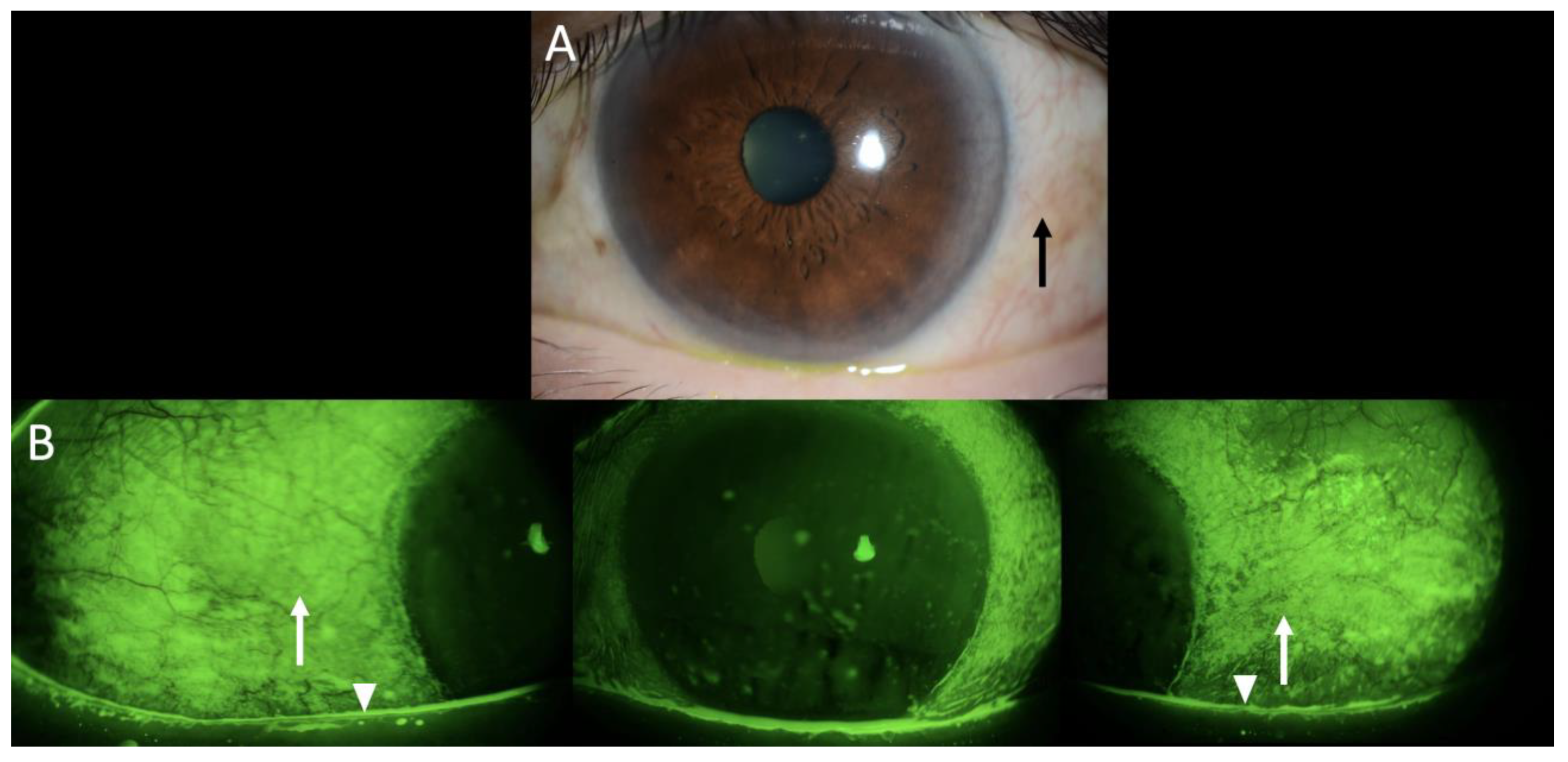Immune Checkpoint Inhibitor-Related Sjögren’s Syndrome: An Ocular Immune-Related Adverse Event
Abstract
Author Contributions
Funding
Institutional Review Board Statement
Informed Consent Statement
Data Availability Statement
Conflicts of Interest
References
- Quiruz, L.; Yavari, N.; Kikani, B.; Gupta, A.S.; Wai, K.M.; Kossler, A.L.; Ludwig, C.; Koo, E.B.; Rahimy, E.; Mruthyunjaya, P. Ophthalmic Immune-Related Adverse Events and Association with Survival: Results From a Real-World Database. Am. J. Ophthalmol. 2024, 268, 348–359. [Google Scholar] [CrossRef] [PubMed]
- Fukuoka, H.; Yoshioka, M.; Kobayashi, H.; Okumura, T.; Sotozono, C. A Case of Bilateral Keratitis and Bilateral Anterior Uveitis Induced by Pembrolizumab. Cornea Open 2023, 2, e007. [Google Scholar] [CrossRef]
- Kim, Y.J.; Lee, J.S.; Lee, J.; Lee, S.C.; Kim, T.; Byeon, S.H.; Lee, C.S. Factors Associated with Ocular Adverse Event after Immune Checkpoint Inhibitor Treatment. Cancer Immunol. Immunother. 2020, 69, 2441–2452. [Google Scholar] [CrossRef] [PubMed]
- Thorlacius, G.; Björk, A.; Wahren-Herlenius, M. Genetics and Epigenetics of Primary Sjögren Syndrome: Implications for Future Therapies. Nat. Rev. Rheumatol. 2023, 19, 288–306. [Google Scholar] [CrossRef] [PubMed]
- Abdel-Rahman, O.; Oweira, H.; Petrausch, U.; Helbling, D.; Schmidt, J.; Mannhart, M.; Mehrabi, A.; Schöb, O.; Giryes, A. Immune-Related Ocular Toxicities in Solid Tumor Patients Treated with Immune Checkpoint Inhibitors: A Systematic Review. Expert Rev. Anticancer Ther. 2017, 17, 387–394. [Google Scholar] [CrossRef] [PubMed]
- Le Burel, S.; Champiat, S.; Mateus, C.; Marabelle, A.; Michot, J.M.; Robert, C.; Belkhir, R.; Soria, J.C.; Laghouati, S.; Voisin, A.L.; et al. Prevalence of Immune-Related Systemic Adverse Events in Patients Treated with Anti-Programmed Cell Death 1/Anti-Programmed Cell Death-Ligand 1 Agents: A Single-Centre Pharmacovigilance Database Analysis. Eur. J. Cancer 2017, 82, 34–44. [Google Scholar] [CrossRef] [PubMed]
- Ramos-Casals, M.; Maria, A.; Suárez-Almazor, M.E.; Lambotte, O.; Fisher, B.A.; Hernández-Molina, G.; Guilpain, P.; Pundole, X.; Flores-Chávez, A.; Baldini, C.; et al. Sicca/Sjögren’s Syndrome Triggered by PD-1/PD-L1 Checkpoint Inhibitors. Data from the International Immunocancer Registry (ICIR). Clin. Exp. Rheumatol. 2019, 37, 114–122. [Google Scholar] [PubMed]


Disclaimer/Publisher’s Note: The statements, opinions and data contained in all publications are solely those of the individual author(s) and contributor(s) and not of MDPI and/or the editor(s). MDPI and/or the editor(s) disclaim responsibility for any injury to people or property resulting from any ideas, methods, instructions or products referred to in the content. |
© 2025 by the authors. Licensee MDPI, Basel, Switzerland. This article is an open access article distributed under the terms and conditions of the Creative Commons Attribution (CC BY) license (https://creativecommons.org/licenses/by/4.0/).
Share and Cite
Fukuoka, H.; Matsumoto, A.; Sotozono, C. Immune Checkpoint Inhibitor-Related Sjögren’s Syndrome: An Ocular Immune-Related Adverse Event. Diagnostics 2025, 15, 1168. https://doi.org/10.3390/diagnostics15091168
Fukuoka H, Matsumoto A, Sotozono C. Immune Checkpoint Inhibitor-Related Sjögren’s Syndrome: An Ocular Immune-Related Adverse Event. Diagnostics. 2025; 15(9):1168. https://doi.org/10.3390/diagnostics15091168
Chicago/Turabian StyleFukuoka, Hideki, Akifumi Matsumoto, and Chie Sotozono. 2025. "Immune Checkpoint Inhibitor-Related Sjögren’s Syndrome: An Ocular Immune-Related Adverse Event" Diagnostics 15, no. 9: 1168. https://doi.org/10.3390/diagnostics15091168
APA StyleFukuoka, H., Matsumoto, A., & Sotozono, C. (2025). Immune Checkpoint Inhibitor-Related Sjögren’s Syndrome: An Ocular Immune-Related Adverse Event. Diagnostics, 15(9), 1168. https://doi.org/10.3390/diagnostics15091168





